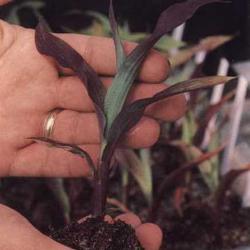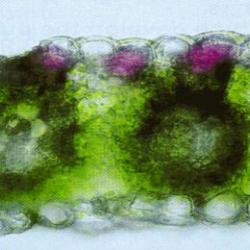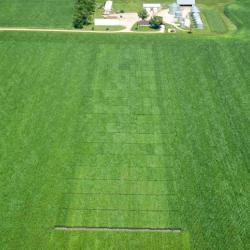Understanding Purple Corn
What Causes Purple Corn?

Purple corn is not a new phenomenon. It has been observed over the years in many inbred and hybrid lines all over the world. Wild corn found growing in the cool mountain regions of Peru and Mexico is often purple.
Purple seedling color results from the expression of genes for anthocyanin pigment formation. Several plants have similar genes. For example, red maples have red leaves in the spring, but other maple varieties have green leaves. Similarly, most cabbage is green, but there is also red cabbage. The differences between the varieties—corn, maple, or cabbage—include the genes for pigment production. That trait, along with other traits you do not see, is inherited in the hybrid or variety.
Most of the corn grown in the United States contains five of eight genes required to produce the purple color. The other three genes are present in certain hybrids, and some of these genes are cold sensitive. When exposed to cool temperatures, they induce purpling in the young plants. Nighttime air temperatures in the 40's when day temperatures are in the 60's are often adequate to trigger purpling.

These temperature-sensitive genes are only expressed in seedlings prior to the six-leaf stage. Since there are likely to be early spring cold temperatures somewhere each year, hybrids with the eight genes for pigment formation will probably produce some purple seedlings each spring.
Purple pigments can accumulate in mature plants as well, but pigmentation then results from the action of different genes.
Research shows no difference.

Testing of corn plants that exhibit genetic purpling at the seedling stage has shown no evidence of adverse effects on metabolism, growth, chlorophyll production, or yield. The cold temperature stress which induces purpling, however, does affect early plant growth. Regardless of whether the corn is purple or green, cool temperatures slow growth. Researchers studying purple corn have observed no difference between cold-stress effects associated with purple seedlings compared to green seedlings. Hybrids that develop the purple pigment when exposed to cold temperatures have been found to contain as much chlorophyll (the green pigment) as hybrids that remain green when grown under the same cool conditions.
Young corn plants that do turn purple grow out of the coloration after the six-leaf stage. This can occur quickly if the weather warms up and the corn grows rapidly, or it can be slow if the weather remains cool, retarding both root and shoot growth in the seedling. The cool temperatures—not the purple pigment—cause slower growth.
Most occurrences of purple seedlings are the result of a combination of cool weather and the genes present in the plant.
Other Causes of Purple Corn
Typically when one hybrid is uniformly purple across the field, the cause is genetic. When the purpling is erratic or patchy in the field other factors may be the cause.
Phosphorus (P) deficiency symptoms have been characterized as an accumulation of purple pigments in leaves. Often there is adequate phosphorus in the soil but the seedling root system may be challenged to adequately absorb enough nutrient. Because the inhibited root system may not take up enough phosphorus for normal growth, excess sugars accumulate in the plant and purple pigments develop.
Check soil tests to insure available P nutrient levels in the field. If P levels are acceptable there are numerous factors that can inhibit seedling root growth and slow the uptake of P:
- cool soil and night temperatures
- dry, cool soils or wet, poorly drained soils
- shallow planting
- soil compaction
- seed furrow compaction or ‘smearing’
- insect or nematode damage
- seedling diseases
- herbicide overlaps or over-applications
- fertilizer injury
Stress Affects Early Growth
Some of the same stress factors that can limit phosphorus availability can also cause uneven early growth. Both green and purple corn plants can exhibit uneven seedling development. Cool temperature stress is often a major stress factor, and this may interact with variable soil conditions, seed placement, compaction, fertilizer placement, and amounts of crop residue.
Literally, each seedling has a unique environment for growth and, as a result, some unevenness in plant development will occur. Growers should only be concerned when uneven growth is abnormally great.
The most critical assessment of seedling stress is stand establishment. If stands are reduced, yield potential may be limited. If adequate stands are achieved, then most research data show seedling growth has little influence on final yields. However, modern agriculture is pushing seedlings into a more stressful environment. Factors increasing stress on seedlings include:
- Cold Soils: Early planting increases the likelihood of cold temperatures during emergence and early seedling growth. Reduced tillage leaves more residues on the soil surface, thus insulating the soil and delaying its warming.
- Tillage: Incorporating high levels of crop residue in the soil can sometimes create challenges to seedlings if they come in contact with pockets of residue in the soil.
- Compaction: Compacted zones can influence soil moisture for germination and limit root growth and nutrient uptake.
- Fertilizer Placement: Banded fertilizer such as anhydrous ammonia or starter fertilizers can affect root growth if placement depth is inadequate or soil conditions turn very dry.
- Pesticide Application: Misapplication of chemicals, including over-application, non-uniform application, and improper incorporation, is a factor that can also affect crop growth and performance.
The stresses we cannot control, such as weather conditions, are likely the most critical. Whether too hot or cold, too wet or dry, the weather will continue to challenge early plant growth for many farmers.
Seedling Appearance Doesn’t Predict Performance
Purple seedlings do indicate cold stress, but be sure to assess the effects of that cold stress in all fields, not just those with purple seedlings. Remember, too, that stand establishment is the most critical seedling trait because stand differences can affect final yield potential.
Corn plants are very resilient. They can withstand a great deal of early-season stress and come back to grow and yield well. Seedling appearance generally does not affect final crop performance as long as there is an adequate stand.
If the seedlings are purple, chances are it's simply a genetic trait that won't affect performance. If the cause is not genetic, then there may be an actual or induced phosphorus deficiency caused by stress. “Induced” phosphorus deficiency is often due to inhibition of the root system in corn seedlings.
If seedlings develop unevenly, remember that some of the same stress factors that inhibit phosphorus uptake by plants can also cause uneven early growth. These factors include temperature, soil type, tillage practices, compaction, moisture, fertility, insects, pesticides and hybrid.
